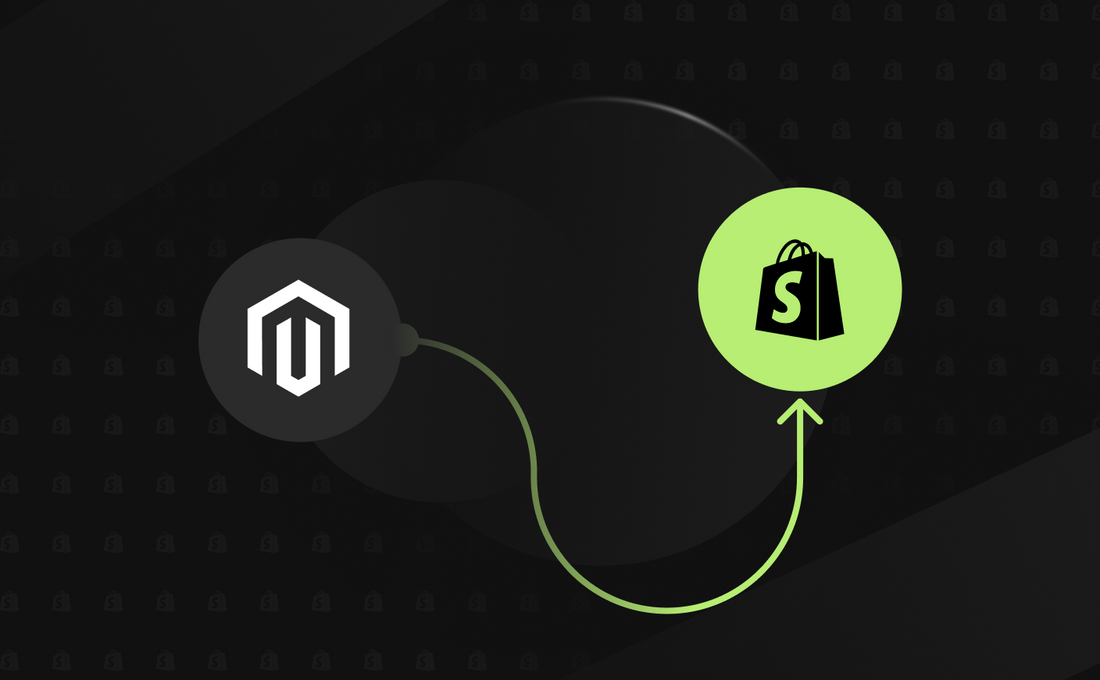Magento to Shopify Migration: Everything You Must Know
Magento to Shopify migration

If you are still running your online store on Magento, ask yourself, is it really helping your business grow or just holding it back?
In a market where customer expectations are rising every single day and global ecommerce sales are racing toward $8 trillion by 2027, sticking with a high-maintenance platform like Magento could cost you more than you think.
That is exactly why thousands of businesses are making the move to Shopify.
This blog is not another Magento to Shopify migration checklist. It is a “no-nonsense” guide for ecommerce marketers who are tired of dealing with technical roadblocks and are ready for a platform that works with them, not against them.
Why Magento to Shopify Migration Is Essential In 2025?
Let us take a closer look at why moving from Magento into Shopify matters in 2025.
#1 Cost Efficiency
Magento often demands large ongoing investments in hosting, security patches, developer support, and server maintenance.
However, Shopify offers transparent monthly plans (Basic, Shopify, Advanced, Plus) that include hosting, security, and updates. New users can often benefit from trial deals like $1/month for the first three months.
Example: Jeff Moriarty from Moriarty’s Gem Art found Shopify migration costs were just 25% of what Magento 2 would have required, and they continue to enjoy lower operating expenses. (source: cisin)
#2 Ease of Use and Reduced Technical Overhead
Magento offers customization but demands coding skills for updates, theme changes, and server management. This creates a constant need for developer support, increasing costs and slowing business operations.
For many merchants, this complexity shifts focus away from growth.
But Shopify with its user-friendly dashboard, drag-and-drop theme editor, and guided onboarding is designed for non-technical users. Merchants can manage products, customize their store, and install apps without expert help.
Shopify’s built-in tools also reduce development time. This enables faster store launches, quick updates, and easy scaling, giving merchants more freedom to focus on growing their business.
#3 Scalability for Growing Businesses
Magento supports large catalogs and heavy traffic but scaling often demands server upgrades, performance tuning, and constant developer support. This adds cost and complexity, especially during peak seasons or rapid growth.
Shopify removes these hurdles with its global content delivery network and unlimited bandwidth. This ensures stores perform smoothly even during traffic spikes like Black Friday. For enterprises, Shopify Plus offers advanced APIs, automation tools, and B2B capabilities. Therefore, it gives brands the scalability without technical strain.
Global companies like Red Bull trust Shopify to manage massive traffic loads, proving it can handle growth for businesses of any size with ease and reliability.
Also read: Shopify summer editions 2025: What’s new, what’s next
#4 Better Security and Compliance
Magento requires merchants to handle critical security tasks like installing patches, managing SSL certificates, and ensuring PCI compliance. This adds ongoing responsibility, technical complexity, and the risk of vulnerabilities if updates are missed.
Shopify eliminates this concern by offering built-in security features. Every Shopify store comes with automatic SSL encryption, PCI DSS Level 1 compliance, and continuous monitoring. This allows merchants to focus on growth while Shopify handles protection, reducing both risk and operational workload.
#5 App Ecosystem and Integrations
Magento’s flexibility comes with the challenge of managing custom extensions. This often requires custom development and creates compatibility issues with updates. It adds to costs and complicates store management.
Shopify simplifies this with its vast App Store, offering over 8,000 plug-and-play apps for marketing, design, SEO, and conversion optimization. Tools like Boost AI Search and PageFly improves functionality without coding. And all this can be done without any complex integrations or ongoing developer support.
Top 5 Things To Consider Before Magento to Shopify Migration
Let us break down the key factors you must consider before making the move.
#1 Assess Your Business Needs
Before you begin, assess whether Shopify aligns with your current business size, order volume, and long-term goals. The platform offers tiered plans such as Basic, Shopify, Advanced, and Plus. Each one of them is designed to support different business levels.
Also, consider your product complexity. Shopify supports up to 99 variants per product and three options (such as size, color, material). If your business operates with highly configurable products or large catalogs with complex variants, you may need to rethink product structuring or use specialized Shopify apps to manage them effectively.
For B2B businesses, Shopify Plus offers features like custom pricing, wholesale portals, and advanced API access. However, Magento may still have an edge in fully customized B2B setups with complex workflows.
Carefully evaluate whether Shopify’s B2B tools meet your operational needs before switching.
Also read: Why more brands are choosing blended Shopify B2B stores in 2025
#2 Data Migration Scope
Knowing what data can be transferred and what cannot is crucial for setting realistic migration goals.
What You Can Migrate:
- Products: Including names, SKUs, descriptions, pricing, reviews, images, variants, and SEO data like meta titles and descriptions.
- Customers: Names, email addresses, and billing or shipping information. However, customer passwords are encrypted and cannot be migrated, meaning customers will need to reset their passwords post-migration.
- Orders: Order history, details, statuses, and shipping information can be transferred.
- Static Pages: Content like About Us, Contact, and FAQ pages may require manual setup or formatting adjustments.
- SEO Data: Meta titles, descriptions, and URL redirects can be migrated to protect your search rankings.
- Blog Posts: This can be migrated using third-party tools like Matrixify or manual export and import methods.
- Discounts: Existing discount codes, rules, and offers from Magento can be transferred into Shopify using apps or manual setup. Shopify’s built-in discount engine allows you to recreate your promotional campaigns and manage discount codes effectively post-migration.
Before migrating, it is wise to clean up your data. Remove outdated products, duplicates, and irrelevant content to ensure a smooth transfer and optimize store performance post-launch.
#3 SEO and Magento
Magento and Shopify use different URL structures, so creating a URL mapping sheet for 301 redirects is essential to avoid broken links and loss of traffic.
Your SEO strategy should include:
- Mapping all old URLs to the new Shopify URLs
- Preserving meta titles, descriptions, and alt texts
- Setting up and verifying your domain in Google Search Console after migration
#4 Theme and Design Compatibility
Magento themes are not compatible with Shopify. You will need to choose a new theme from the Shopify Theme Store or develop a custom design.
Shopify offers both free themes like Dawn and premium options, all of which are customizable via the drag-and-drop editor or Liquid coding.
For brands seeking advanced design flexibility, tools like GemPages or PageFly offer drag-and-drop builders designed for high-conversion stores.
#5 Budget and Timeline Planning
Plan your budget with all factors in mind:
- Migration tools like Matrixify
- Shopify subscription fees and app costs
- Agency or developer fees if customizations are needed
For small stores with under 1,000 products, migration can take a few weeks. Larger catalogs or stores with custom integrations may require more time.
Finally, avoid migrating during peak sales periods such as holidays or major promotions to prevent downtime risks and customer service disruptions. A well-timed migration helps ensure a smoother transition with minimal impact on sales.
Challenges And How To Overcome Them
Here are the key challenges and proven solutions to help you transition smoothly.
#1 Data Loss and Integrity
Challenge:
Data loss or corruption is a common risk, especially when migrating complex product catalogs, customer records, or custom fields. Missing product variants, broken images, or incomplete customer data can disrupt operations.
Solution:
Always perform a full backup of your Magento store including system files, database, and media before starting migration. Use trusted migration tools like Matrixify or LitExtension for automated and secure data transfer.
After migration, conduct a thorough audit to check products, customer data, and order history for completeness and accuracy.
#2 SEO and Traffic Disruptions
Challenge:
URL structure differences between Magento and Shopify can lead to broken links and lost SEO rankings if not handled correctly.
Solution:
Map all existing URLs and implement 301 redirects for every important page. You can use SEO apps like Plug In SEO to optimize your new store after the migration is done.
Monitor your SEO performance using Google Analytics and Google Search Console, making sure to exclude internal traffic for accurate reporting.
#3 Feature and Integration Gaps
Challenge:
Magento’s custom modules or integrations may not have direct Shopify equivalents, affecting functionality.
Solution:
Audit all current extensions and integrations. Find Shopify app alternatives, for example, using Klaviyo for email marketing. For features with no app solution, hire a developer to build custom API connections.
#4 Customer Experience Continuity
Challenge:
Passwords cannot be migrated, forcing customers to reactivate accounts, which may affect retention.
Solution:
Communicate clearly about the migration via email and social media. Provide easy password reset guides and consider offering incentives like discounts to encourage account reactivation.
#5 Downtime And Performance Risks
Challenge:
Store downtime during migration can lead to lost sales and customer frustration.
Solution:
Use tools like Matrixify to migrate data while keeping your Magento store live. Test your Shopify store thoroughly before launch to ensure everything works smoothly and avoid last-minute issues.
Also read: 5 Best Shopify B2B services every brand needs in 2025
Why Choose Matrixify When You Migrate To Shopify From Magento
Matrixify is a powerful Shopify app designed to simplify complex data migration, making it ideal for Magento to Shopify transitions in 2025. It helps merchants move large volumes of data smoothly while minimizing downtime and errors.
Key Features:
- Supports bulk import and export of products, customers, orders, and metafields using CSV, Excel, or XML
- Allows customizable field mapping from Magento to Shopify
- Real-time data syncing to avoid disruptions during migration
Benefits:
- Automates large-scale migrations with speed and accuracy
- Intuitive, no-code interface suitable for all users
- Offers a free trial with demo mode for testing
Migrating from Magento to Shopify is a strategic move that demands careful planning, the right tools, and a clear understanding of your business goals. While the process comes with challenges, a thoughtful approach backed by reliable solutions ensures a smooth transition.
Frequently Asked Questions
Is it possible to migrate customer passwords from Magento to Shopify?
No, customer passwords cannot be migrated due to encryption protocols in both platforms. This is a security standard followed by Shopify and Magento. After migration, you send users an activation account email to reset their password. They can reset their password after clicking on that email.
Will migrating from Magento to Shopify affect my SEO rankings?
Migration can impact SEO if not handled carefully. However, by setting up 301 redirects, preserving meta titles and descriptions, and verifying your site in Google Search Console post-migration, you can protect your rankings. Shopify’s fast loading times and mobile-optimized themes also help align with Google’s Core Web Vitals, supporting strong Shopify SEO performance after the move.
How long does a Magento to Shopify migration usually take?
The timeline varies based on your store’s size and complexity. Small stores with fewer than 1,000 products can complete migration within two to four weeks. Larger stores with custom features may take several months. Always factor in additional time for data cleanup, SEO adjustments, and thorough testing before going live.
Can I keep my Magento store active while migrating to Shopify?
Yes, you can keep your Magento store running during the migration process. Tools like Matrixify allows you to transfer data while your Magento store remains live. This ensures there is no disruption in customer service or sales. After final testing on Shopify, you can switch domains and officially launch your new store.















